Criminal Justice Case Study: Ethical and Professional Responsibilities
VerifiedAdded on 2022/12/27
|8
|2116
|1
Case Study
AI Summary
This case study examines a scenario involving a breach of confidentiality within the criminal justice system. A legal professional leaked confidential case information, raising ethical questions about justice, non-maleficence, and professional conduct. The assignment analyzes the ethical dilemma, considering social and professional responsibilities. It explores the importance of maintaining confidentiality, the impact of such breaches on the accused and the public, and the role of ethical guidelines like the Legal Profession Act 2006 and NSW guidelines in addressing such issues. The analysis provides insights into ethical decision-making processes within the justice system, emphasizing the need for transparency, integrity, and adherence to ethical principles. The case study offers a detailed discussion of how to handle such issues, and the importance of professional ethics.
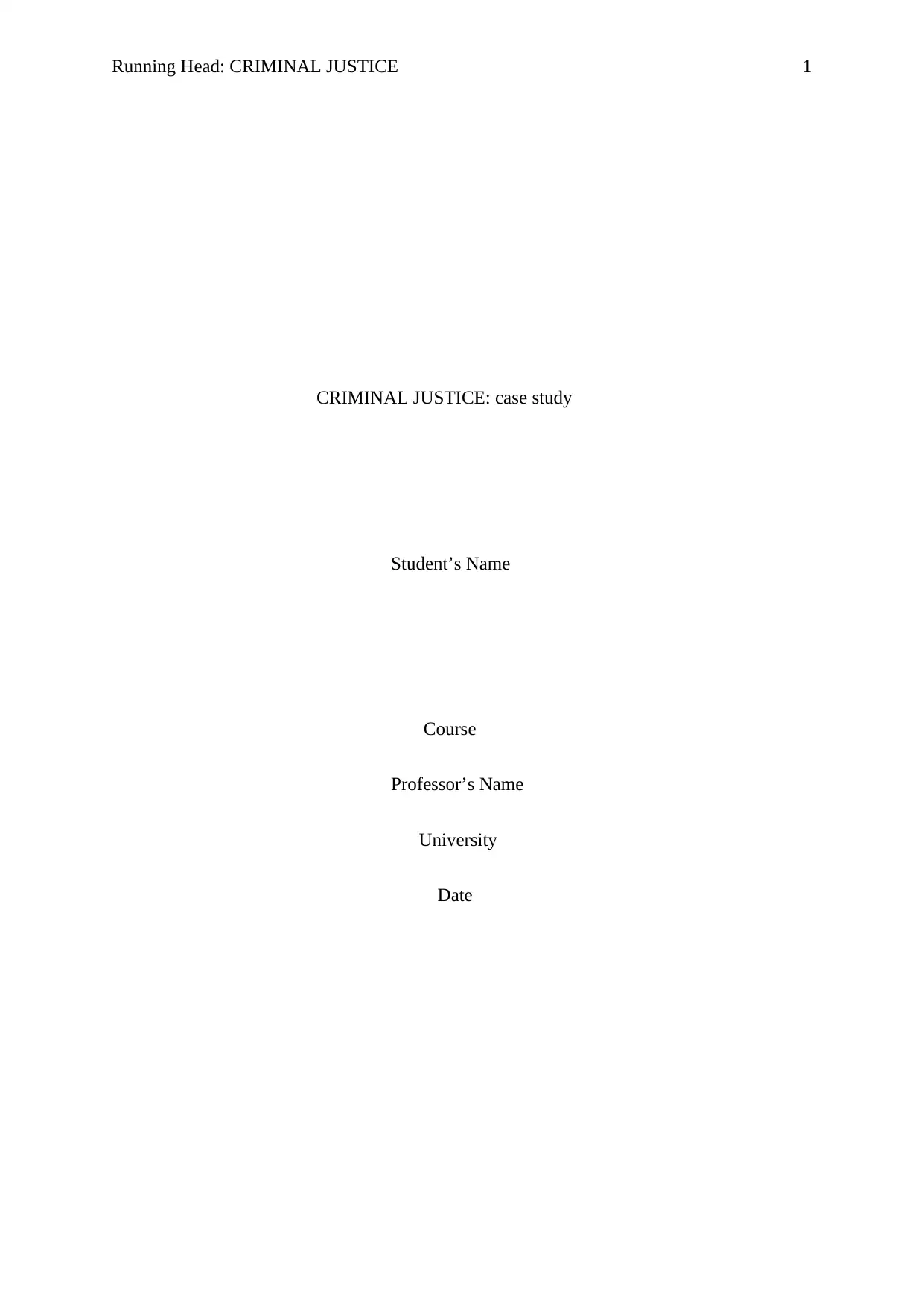
Running Head: CRIMINAL JUSTICE 1
CRIMINAL JUSTICE: case study
Student’s Name
Course
Professor’s Name
University
Date
CRIMINAL JUSTICE: case study
Student’s Name
Course
Professor’s Name
University
Date
Paraphrase This Document
Need a fresh take? Get an instant paraphrase of this document with our AI Paraphraser
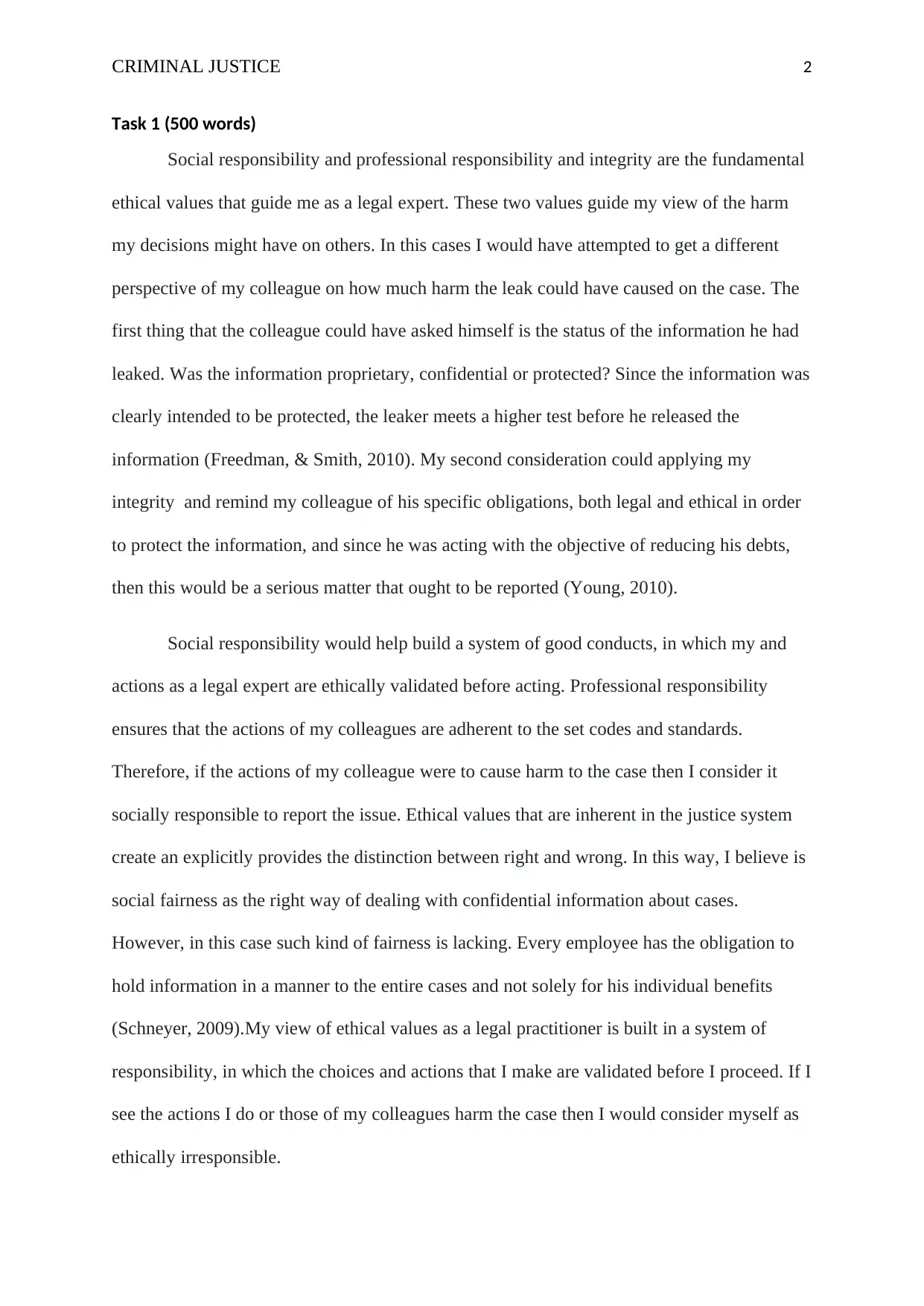
CRIMINAL JUSTICE 2
Task 1 (500 words)
Social responsibility and professional responsibility and integrity are the fundamental
ethical values that guide me as a legal expert. These two values guide my view of the harm
my decisions might have on others. In this cases I would have attempted to get a different
perspective of my colleague on how much harm the leak could have caused on the case. The
first thing that the colleague could have asked himself is the status of the information he had
leaked. Was the information proprietary, confidential or protected? Since the information was
clearly intended to be protected, the leaker meets a higher test before he released the
information (Freedman, & Smith, 2010). My second consideration could applying my
integrity and remind my colleague of his specific obligations, both legal and ethical in order
to protect the information, and since he was acting with the objective of reducing his debts,
then this would be a serious matter that ought to be reported (Young, 2010).
Social responsibility would help build a system of good conducts, in which my and
actions as a legal expert are ethically validated before acting. Professional responsibility
ensures that the actions of my colleagues are adherent to the set codes and standards.
Therefore, if the actions of my colleague were to cause harm to the case then I consider it
socially responsible to report the issue. Ethical values that are inherent in the justice system
create an explicitly provides the distinction between right and wrong. In this way, I believe is
social fairness as the right way of dealing with confidential information about cases.
However, in this case such kind of fairness is lacking. Every employee has the obligation to
hold information in a manner to the entire cases and not solely for his individual benefits
(Schneyer, 2009).My view of ethical values as a legal practitioner is built in a system of
responsibility, in which the choices and actions that I make are validated before I proceed. If I
see the actions I do or those of my colleagues harm the case then I would consider myself as
ethically irresponsible.
Task 1 (500 words)
Social responsibility and professional responsibility and integrity are the fundamental
ethical values that guide me as a legal expert. These two values guide my view of the harm
my decisions might have on others. In this cases I would have attempted to get a different
perspective of my colleague on how much harm the leak could have caused on the case. The
first thing that the colleague could have asked himself is the status of the information he had
leaked. Was the information proprietary, confidential or protected? Since the information was
clearly intended to be protected, the leaker meets a higher test before he released the
information (Freedman, & Smith, 2010). My second consideration could applying my
integrity and remind my colleague of his specific obligations, both legal and ethical in order
to protect the information, and since he was acting with the objective of reducing his debts,
then this would be a serious matter that ought to be reported (Young, 2010).
Social responsibility would help build a system of good conducts, in which my and
actions as a legal expert are ethically validated before acting. Professional responsibility
ensures that the actions of my colleagues are adherent to the set codes and standards.
Therefore, if the actions of my colleague were to cause harm to the case then I consider it
socially responsible to report the issue. Ethical values that are inherent in the justice system
create an explicitly provides the distinction between right and wrong. In this way, I believe is
social fairness as the right way of dealing with confidential information about cases.
However, in this case such kind of fairness is lacking. Every employee has the obligation to
hold information in a manner to the entire cases and not solely for his individual benefits
(Schneyer, 2009).My view of ethical values as a legal practitioner is built in a system of
responsibility, in which the choices and actions that I make are validated before I proceed. If I
see the actions I do or those of my colleagues harm the case then I would consider myself as
ethically irresponsible.
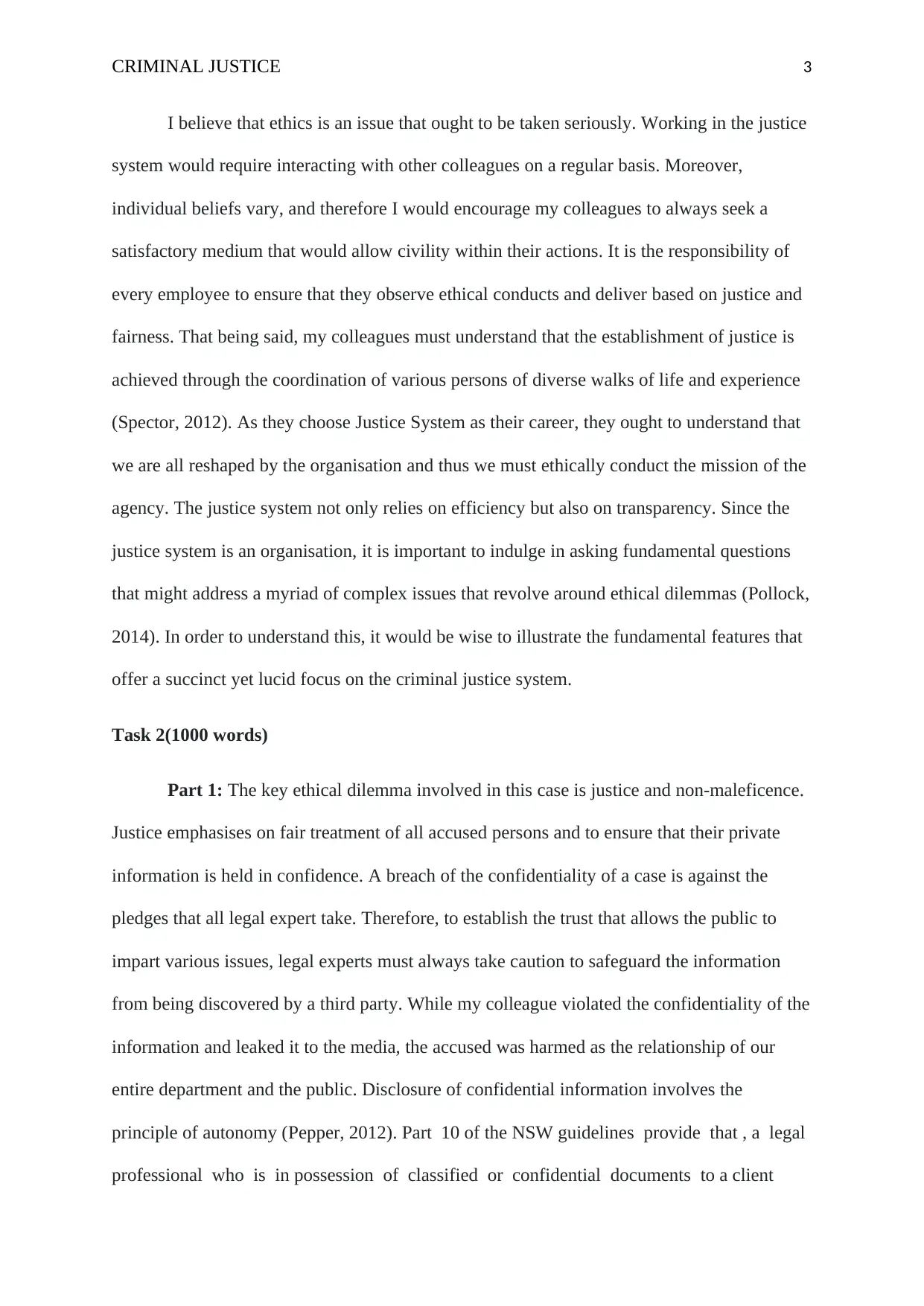
CRIMINAL JUSTICE 3
I believe that ethics is an issue that ought to be taken seriously. Working in the justice
system would require interacting with other colleagues on a regular basis. Moreover,
individual beliefs vary, and therefore I would encourage my colleagues to always seek a
satisfactory medium that would allow civility within their actions. It is the responsibility of
every employee to ensure that they observe ethical conducts and deliver based on justice and
fairness. That being said, my colleagues must understand that the establishment of justice is
achieved through the coordination of various persons of diverse walks of life and experience
(Spector, 2012). As they choose Justice System as their career, they ought to understand that
we are all reshaped by the organisation and thus we must ethically conduct the mission of the
agency. The justice system not only relies on efficiency but also on transparency. Since the
justice system is an organisation, it is important to indulge in asking fundamental questions
that might address a myriad of complex issues that revolve around ethical dilemmas (Pollock,
2014). In order to understand this, it would be wise to illustrate the fundamental features that
offer a succinct yet lucid focus on the criminal justice system.
Task 2(1000 words)
Part 1: The key ethical dilemma involved in this case is justice and non-maleficence.
Justice emphasises on fair treatment of all accused persons and to ensure that their private
information is held in confidence. A breach of the confidentiality of a case is against the
pledges that all legal expert take. Therefore, to establish the trust that allows the public to
impart various issues, legal experts must always take caution to safeguard the information
from being discovered by a third party. While my colleague violated the confidentiality of the
information and leaked it to the media, the accused was harmed as the relationship of our
entire department and the public. Disclosure of confidential information involves the
principle of autonomy (Pepper, 2012). Part 10 of the NSW guidelines provide that , a legal
professional who is in possession of classified or confidential documents to a client
I believe that ethics is an issue that ought to be taken seriously. Working in the justice
system would require interacting with other colleagues on a regular basis. Moreover,
individual beliefs vary, and therefore I would encourage my colleagues to always seek a
satisfactory medium that would allow civility within their actions. It is the responsibility of
every employee to ensure that they observe ethical conducts and deliver based on justice and
fairness. That being said, my colleagues must understand that the establishment of justice is
achieved through the coordination of various persons of diverse walks of life and experience
(Spector, 2012). As they choose Justice System as their career, they ought to understand that
we are all reshaped by the organisation and thus we must ethically conduct the mission of the
agency. The justice system not only relies on efficiency but also on transparency. Since the
justice system is an organisation, it is important to indulge in asking fundamental questions
that might address a myriad of complex issues that revolve around ethical dilemmas (Pollock,
2014). In order to understand this, it would be wise to illustrate the fundamental features that
offer a succinct yet lucid focus on the criminal justice system.
Task 2(1000 words)
Part 1: The key ethical dilemma involved in this case is justice and non-maleficence.
Justice emphasises on fair treatment of all accused persons and to ensure that their private
information is held in confidence. A breach of the confidentiality of a case is against the
pledges that all legal expert take. Therefore, to establish the trust that allows the public to
impart various issues, legal experts must always take caution to safeguard the information
from being discovered by a third party. While my colleague violated the confidentiality of the
information and leaked it to the media, the accused was harmed as the relationship of our
entire department and the public. Disclosure of confidential information involves the
principle of autonomy (Pepper, 2012). Part 10 of the NSW guidelines provide that , a legal
professional who is in possession of classified or confidential documents to a client
⊘ This is a preview!⊘
Do you want full access?
Subscribe today to unlock all pages.

Trusted by 1+ million students worldwide
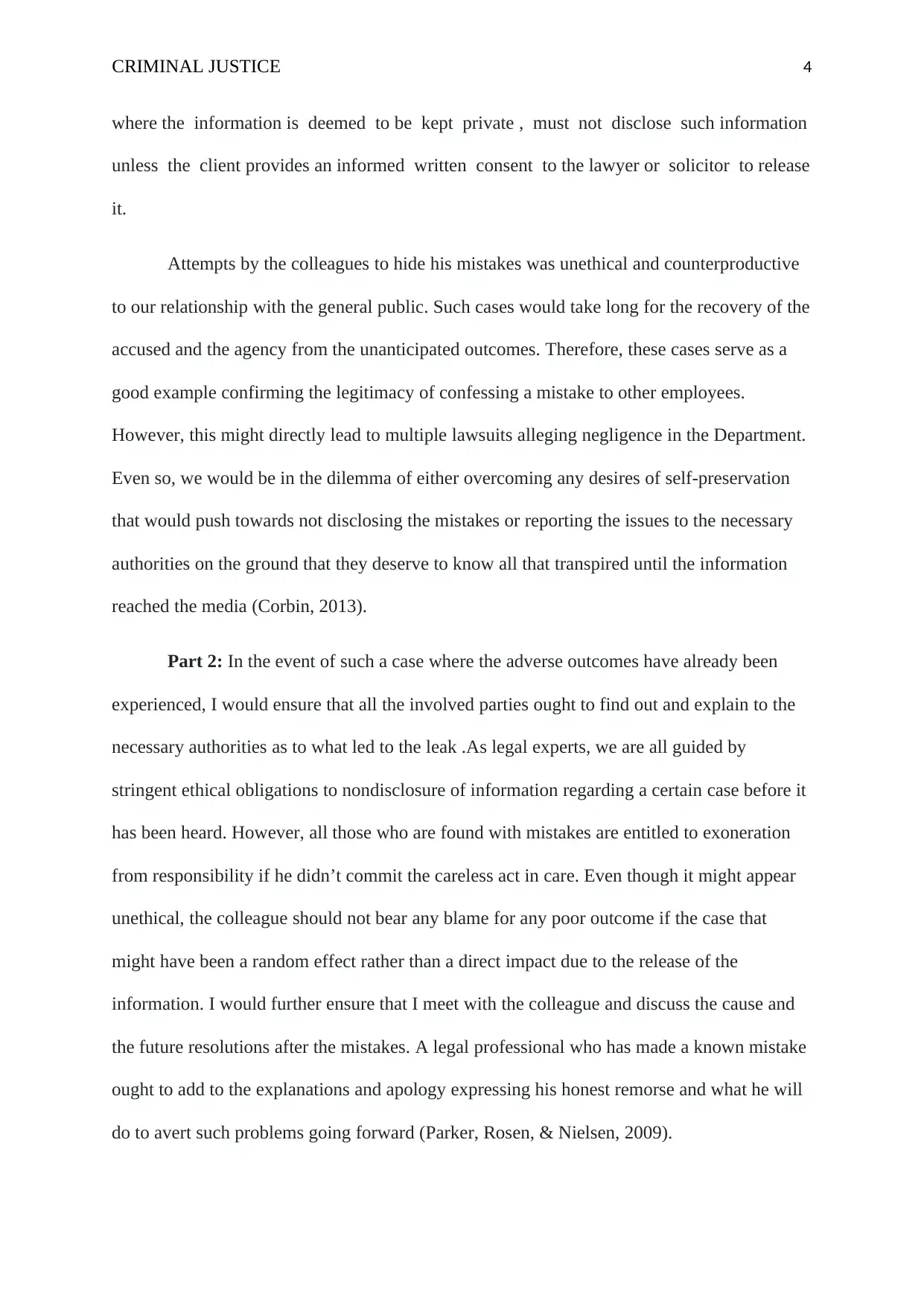
CRIMINAL JUSTICE 4
where the information is deemed to be kept private , must not disclose such information
unless the client provides an informed written consent to the lawyer or solicitor to release
it.
Attempts by the colleagues to hide his mistakes was unethical and counterproductive
to our relationship with the general public. Such cases would take long for the recovery of the
accused and the agency from the unanticipated outcomes. Therefore, these cases serve as a
good example confirming the legitimacy of confessing a mistake to other employees.
However, this might directly lead to multiple lawsuits alleging negligence in the Department.
Even so, we would be in the dilemma of either overcoming any desires of self-preservation
that would push towards not disclosing the mistakes or reporting the issues to the necessary
authorities on the ground that they deserve to know all that transpired until the information
reached the media (Corbin, 2013).
Part 2: In the event of such a case where the adverse outcomes have already been
experienced, I would ensure that all the involved parties ought to find out and explain to the
necessary authorities as to what led to the leak .As legal experts, we are all guided by
stringent ethical obligations to nondisclosure of information regarding a certain case before it
has been heard. However, all those who are found with mistakes are entitled to exoneration
from responsibility if he didn’t commit the careless act in care. Even though it might appear
unethical, the colleague should not bear any blame for any poor outcome if the case that
might have been a random effect rather than a direct impact due to the release of the
information. I would further ensure that I meet with the colleague and discuss the cause and
the future resolutions after the mistakes. A legal professional who has made a known mistake
ought to add to the explanations and apology expressing his honest remorse and what he will
do to avert such problems going forward (Parker, Rosen, & Nielsen, 2009).
where the information is deemed to be kept private , must not disclose such information
unless the client provides an informed written consent to the lawyer or solicitor to release
it.
Attempts by the colleagues to hide his mistakes was unethical and counterproductive
to our relationship with the general public. Such cases would take long for the recovery of the
accused and the agency from the unanticipated outcomes. Therefore, these cases serve as a
good example confirming the legitimacy of confessing a mistake to other employees.
However, this might directly lead to multiple lawsuits alleging negligence in the Department.
Even so, we would be in the dilemma of either overcoming any desires of self-preservation
that would push towards not disclosing the mistakes or reporting the issues to the necessary
authorities on the ground that they deserve to know all that transpired until the information
reached the media (Corbin, 2013).
Part 2: In the event of such a case where the adverse outcomes have already been
experienced, I would ensure that all the involved parties ought to find out and explain to the
necessary authorities as to what led to the leak .As legal experts, we are all guided by
stringent ethical obligations to nondisclosure of information regarding a certain case before it
has been heard. However, all those who are found with mistakes are entitled to exoneration
from responsibility if he didn’t commit the careless act in care. Even though it might appear
unethical, the colleague should not bear any blame for any poor outcome if the case that
might have been a random effect rather than a direct impact due to the release of the
information. I would further ensure that I meet with the colleague and discuss the cause and
the future resolutions after the mistakes. A legal professional who has made a known mistake
ought to add to the explanations and apology expressing his honest remorse and what he will
do to avert such problems going forward (Parker, Rosen, & Nielsen, 2009).
Paraphrase This Document
Need a fresh take? Get an instant paraphrase of this document with our AI Paraphraser
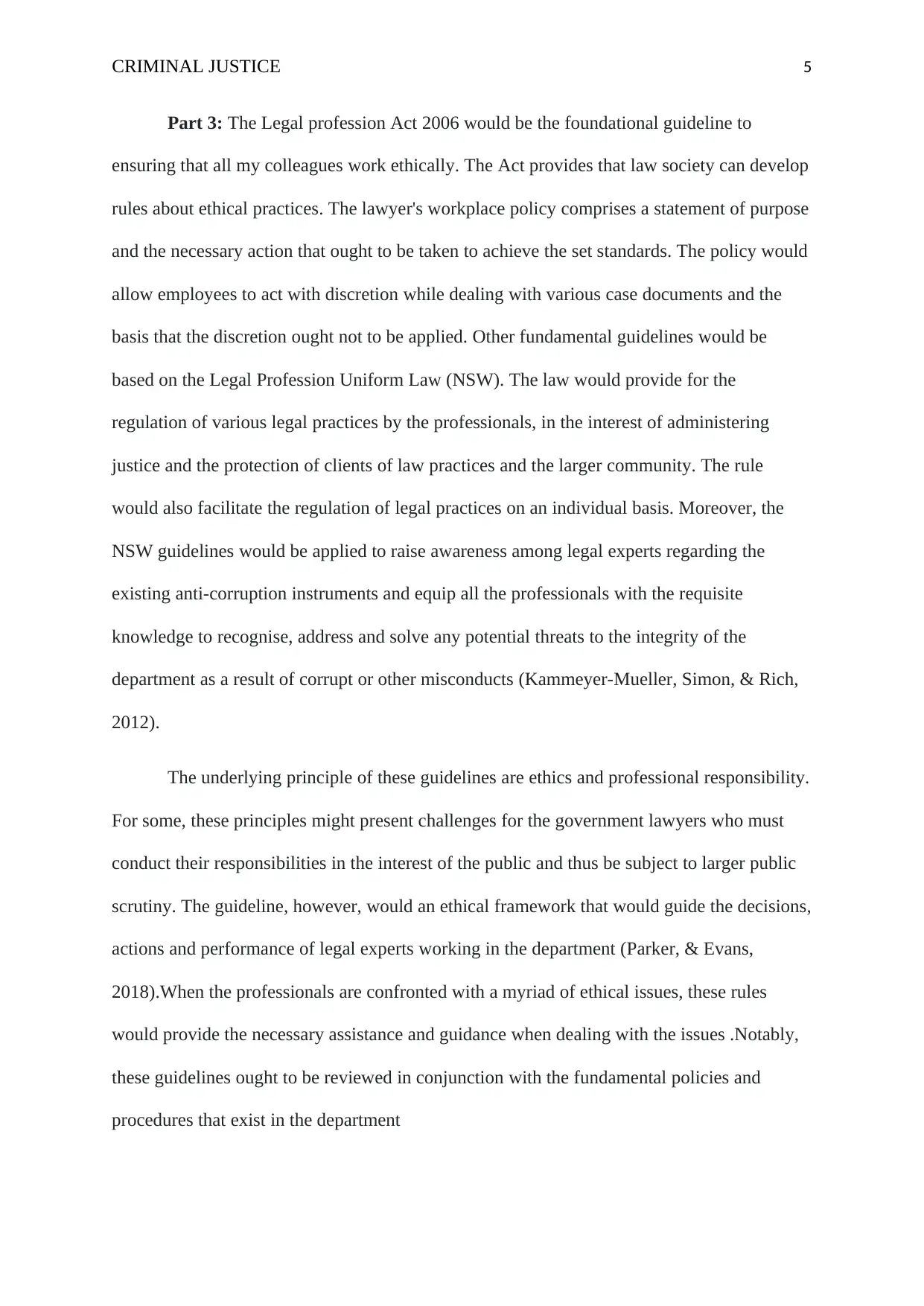
CRIMINAL JUSTICE 5
Part 3: The Legal profession Act 2006 would be the foundational guideline to
ensuring that all my colleagues work ethically. The Act provides that law society can develop
rules about ethical practices. The lawyer's workplace policy comprises a statement of purpose
and the necessary action that ought to be taken to achieve the set standards. The policy would
allow employees to act with discretion while dealing with various case documents and the
basis that the discretion ought not to be applied. Other fundamental guidelines would be
based on the Legal Profession Uniform Law (NSW). The law would provide for the
regulation of various legal practices by the professionals, in the interest of administering
justice and the protection of clients of law practices and the larger community. The rule
would also facilitate the regulation of legal practices on an individual basis. Moreover, the
NSW guidelines would be applied to raise awareness among legal experts regarding the
existing anti-corruption instruments and equip all the professionals with the requisite
knowledge to recognise, address and solve any potential threats to the integrity of the
department as a result of corrupt or other misconducts (Kammeyer-Mueller, Simon, & Rich,
2012).
The underlying principle of these guidelines are ethics and professional responsibility.
For some, these principles might present challenges for the government lawyers who must
conduct their responsibilities in the interest of the public and thus be subject to larger public
scrutiny. The guideline, however, would an ethical framework that would guide the decisions,
actions and performance of legal experts working in the department (Parker, & Evans,
2018).When the professionals are confronted with a myriad of ethical issues, these rules
would provide the necessary assistance and guidance when dealing with the issues .Notably,
these guidelines ought to be reviewed in conjunction with the fundamental policies and
procedures that exist in the department
Part 3: The Legal profession Act 2006 would be the foundational guideline to
ensuring that all my colleagues work ethically. The Act provides that law society can develop
rules about ethical practices. The lawyer's workplace policy comprises a statement of purpose
and the necessary action that ought to be taken to achieve the set standards. The policy would
allow employees to act with discretion while dealing with various case documents and the
basis that the discretion ought not to be applied. Other fundamental guidelines would be
based on the Legal Profession Uniform Law (NSW). The law would provide for the
regulation of various legal practices by the professionals, in the interest of administering
justice and the protection of clients of law practices and the larger community. The rule
would also facilitate the regulation of legal practices on an individual basis. Moreover, the
NSW guidelines would be applied to raise awareness among legal experts regarding the
existing anti-corruption instruments and equip all the professionals with the requisite
knowledge to recognise, address and solve any potential threats to the integrity of the
department as a result of corrupt or other misconducts (Kammeyer-Mueller, Simon, & Rich,
2012).
The underlying principle of these guidelines are ethics and professional responsibility.
For some, these principles might present challenges for the government lawyers who must
conduct their responsibilities in the interest of the public and thus be subject to larger public
scrutiny. The guideline, however, would an ethical framework that would guide the decisions,
actions and performance of legal experts working in the department (Parker, & Evans,
2018).When the professionals are confronted with a myriad of ethical issues, these rules
would provide the necessary assistance and guidance when dealing with the issues .Notably,
these guidelines ought to be reviewed in conjunction with the fundamental policies and
procedures that exist in the department
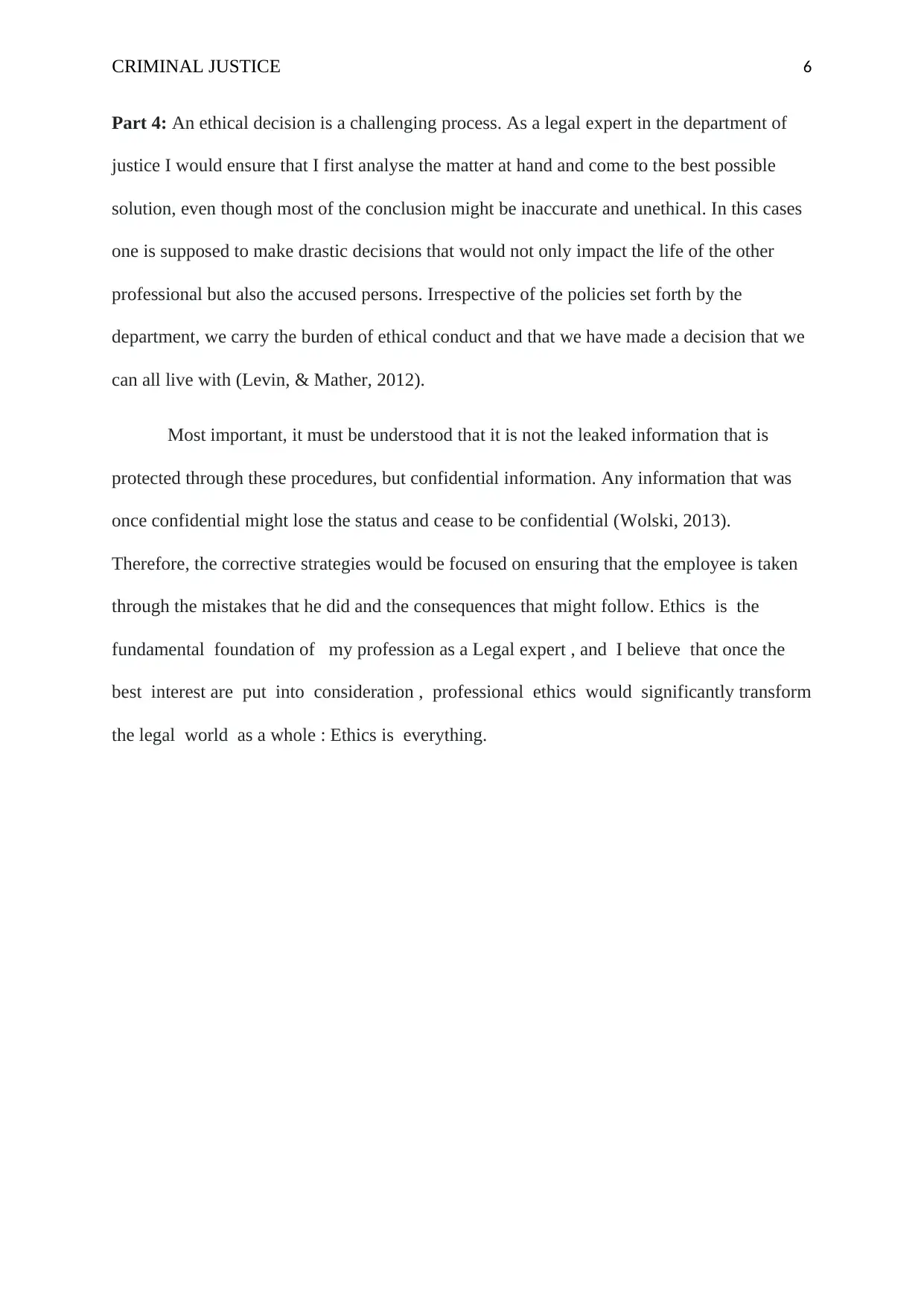
CRIMINAL JUSTICE 6
Part 4: An ethical decision is a challenging process. As a legal expert in the department of
justice I would ensure that I first analyse the matter at hand and come to the best possible
solution, even though most of the conclusion might be inaccurate and unethical. In this cases
one is supposed to make drastic decisions that would not only impact the life of the other
professional but also the accused persons. Irrespective of the policies set forth by the
department, we carry the burden of ethical conduct and that we have made a decision that we
can all live with (Levin, & Mather, 2012).
Most important, it must be understood that it is not the leaked information that is
protected through these procedures, but confidential information. Any information that was
once confidential might lose the status and cease to be confidential (Wolski, 2013).
Therefore, the corrective strategies would be focused on ensuring that the employee is taken
through the mistakes that he did and the consequences that might follow. Ethics is the
fundamental foundation of my profession as a Legal expert , and I believe that once the
best interest are put into consideration , professional ethics would significantly transform
the legal world as a whole : Ethics is everything.
Part 4: An ethical decision is a challenging process. As a legal expert in the department of
justice I would ensure that I first analyse the matter at hand and come to the best possible
solution, even though most of the conclusion might be inaccurate and unethical. In this cases
one is supposed to make drastic decisions that would not only impact the life of the other
professional but also the accused persons. Irrespective of the policies set forth by the
department, we carry the burden of ethical conduct and that we have made a decision that we
can all live with (Levin, & Mather, 2012).
Most important, it must be understood that it is not the leaked information that is
protected through these procedures, but confidential information. Any information that was
once confidential might lose the status and cease to be confidential (Wolski, 2013).
Therefore, the corrective strategies would be focused on ensuring that the employee is taken
through the mistakes that he did and the consequences that might follow. Ethics is the
fundamental foundation of my profession as a Legal expert , and I believe that once the
best interest are put into consideration , professional ethics would significantly transform
the legal world as a whole : Ethics is everything.
⊘ This is a preview!⊘
Do you want full access?
Subscribe today to unlock all pages.

Trusted by 1+ million students worldwide
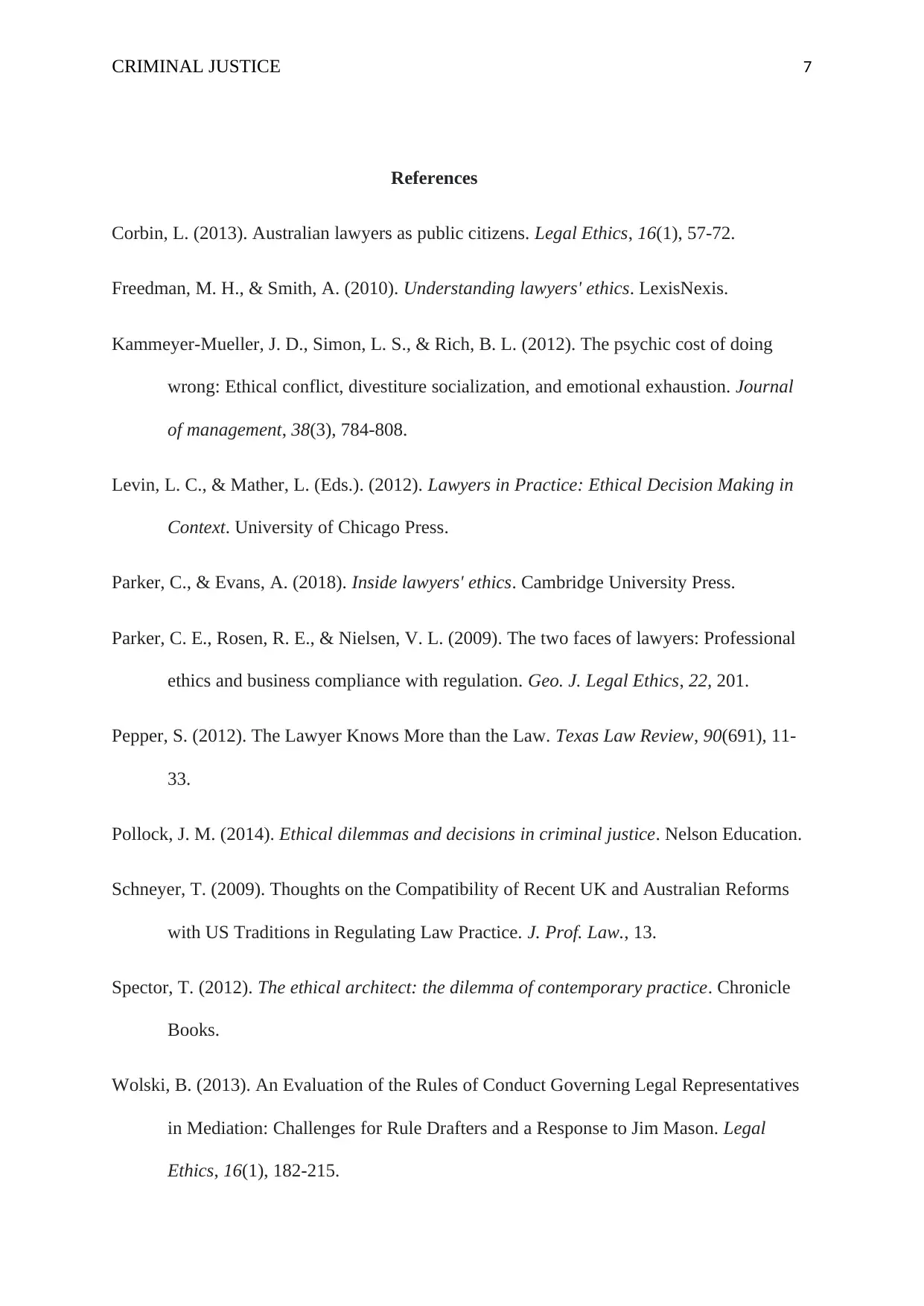
CRIMINAL JUSTICE 7
References
Corbin, L. (2013). Australian lawyers as public citizens. Legal Ethics, 16(1), 57-72.
Freedman, M. H., & Smith, A. (2010). Understanding lawyers' ethics. LexisNexis.
Kammeyer-Mueller, J. D., Simon, L. S., & Rich, B. L. (2012). The psychic cost of doing
wrong: Ethical conflict, divestiture socialization, and emotional exhaustion. Journal
of management, 38(3), 784-808.
Levin, L. C., & Mather, L. (Eds.). (2012). Lawyers in Practice: Ethical Decision Making in
Context. University of Chicago Press.
Parker, C., & Evans, A. (2018). Inside lawyers' ethics. Cambridge University Press.
Parker, C. E., Rosen, R. E., & Nielsen, V. L. (2009). The two faces of lawyers: Professional
ethics and business compliance with regulation. Geo. J. Legal Ethics, 22, 201.
Pepper, S. (2012). The Lawyer Knows More than the Law. Texas Law Review, 90(691), 11-
33.
Pollock, J. M. (2014). Ethical dilemmas and decisions in criminal justice. Nelson Education.
Schneyer, T. (2009). Thoughts on the Compatibility of Recent UK and Australian Reforms
with US Traditions in Regulating Law Practice. J. Prof. Law., 13.
Spector, T. (2012). The ethical architect: the dilemma of contemporary practice. Chronicle
Books.
Wolski, B. (2013). An Evaluation of the Rules of Conduct Governing Legal Representatives
in Mediation: Challenges for Rule Drafters and a Response to Jim Mason. Legal
Ethics, 16(1), 182-215.
References
Corbin, L. (2013). Australian lawyers as public citizens. Legal Ethics, 16(1), 57-72.
Freedman, M. H., & Smith, A. (2010). Understanding lawyers' ethics. LexisNexis.
Kammeyer-Mueller, J. D., Simon, L. S., & Rich, B. L. (2012). The psychic cost of doing
wrong: Ethical conflict, divestiture socialization, and emotional exhaustion. Journal
of management, 38(3), 784-808.
Levin, L. C., & Mather, L. (Eds.). (2012). Lawyers in Practice: Ethical Decision Making in
Context. University of Chicago Press.
Parker, C., & Evans, A. (2018). Inside lawyers' ethics. Cambridge University Press.
Parker, C. E., Rosen, R. E., & Nielsen, V. L. (2009). The two faces of lawyers: Professional
ethics and business compliance with regulation. Geo. J. Legal Ethics, 22, 201.
Pepper, S. (2012). The Lawyer Knows More than the Law. Texas Law Review, 90(691), 11-
33.
Pollock, J. M. (2014). Ethical dilemmas and decisions in criminal justice. Nelson Education.
Schneyer, T. (2009). Thoughts on the Compatibility of Recent UK and Australian Reforms
with US Traditions in Regulating Law Practice. J. Prof. Law., 13.
Spector, T. (2012). The ethical architect: the dilemma of contemporary practice. Chronicle
Books.
Wolski, B. (2013). An Evaluation of the Rules of Conduct Governing Legal Representatives
in Mediation: Challenges for Rule Drafters and a Response to Jim Mason. Legal
Ethics, 16(1), 182-215.
Paraphrase This Document
Need a fresh take? Get an instant paraphrase of this document with our AI Paraphraser
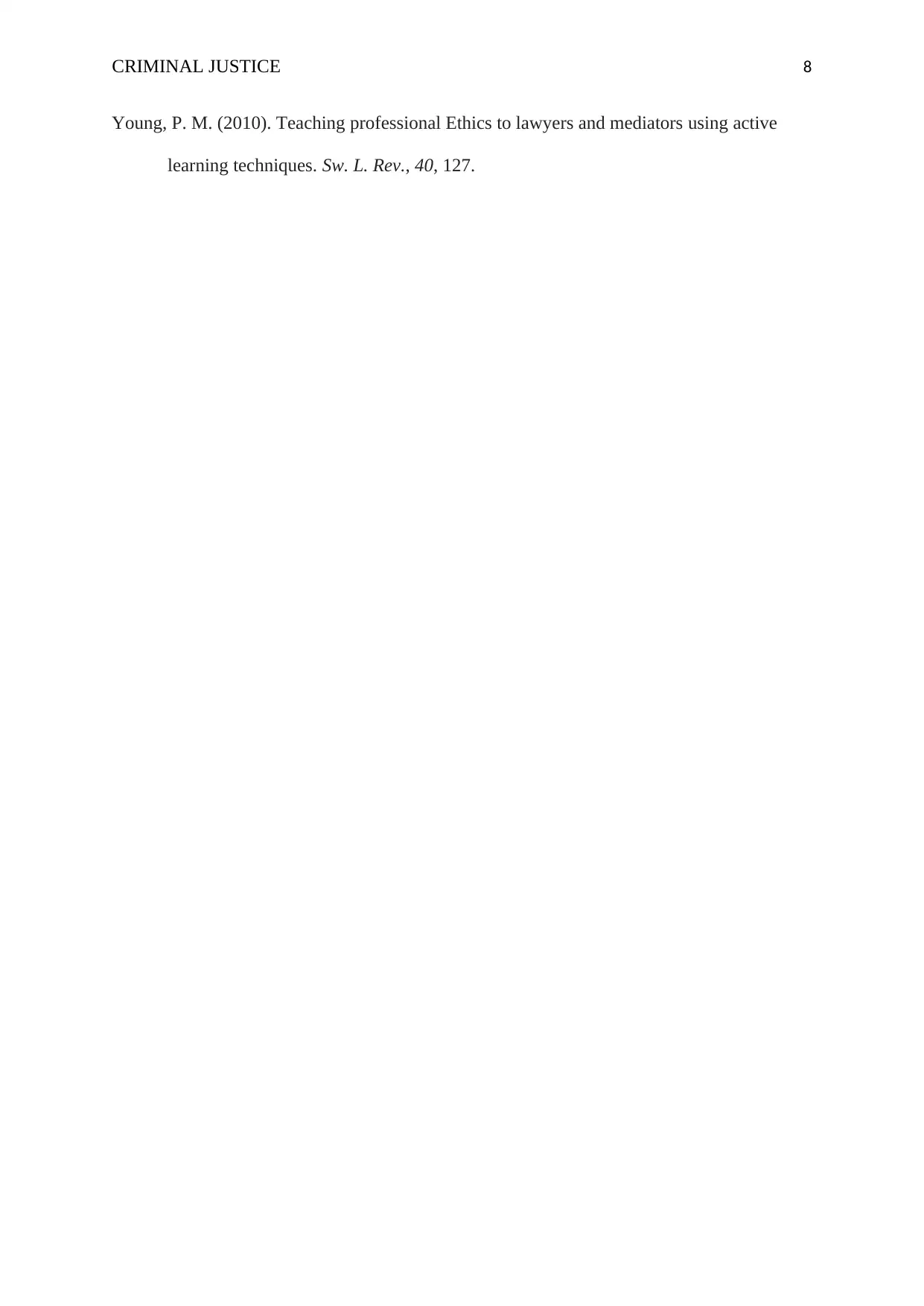
CRIMINAL JUSTICE 8
Young, P. M. (2010). Teaching professional Ethics to lawyers and mediators using active
learning techniques. Sw. L. Rev., 40, 127.
Young, P. M. (2010). Teaching professional Ethics to lawyers and mediators using active
learning techniques. Sw. L. Rev., 40, 127.
1 out of 8
Related Documents
Your All-in-One AI-Powered Toolkit for Academic Success.
+13062052269
info@desklib.com
Available 24*7 on WhatsApp / Email
![[object Object]](/_next/static/media/star-bottom.7253800d.svg)
Unlock your academic potential
Copyright © 2020–2025 A2Z Services. All Rights Reserved. Developed and managed by ZUCOL.





